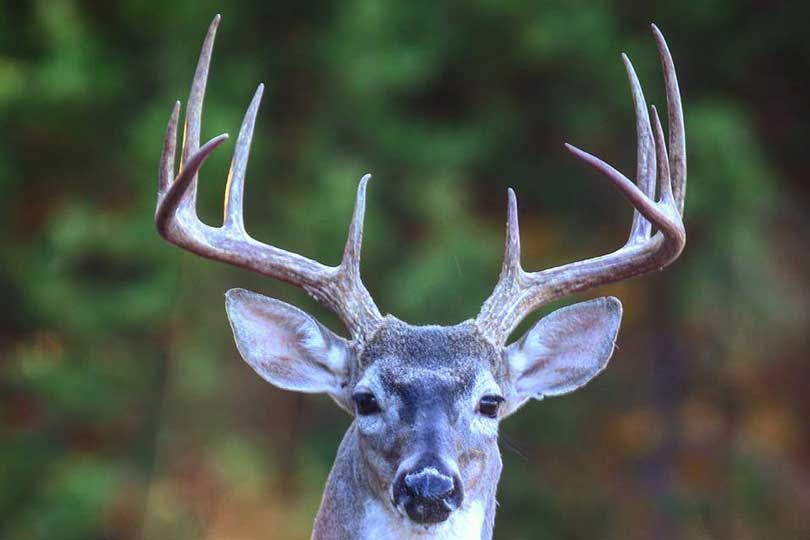By Jessica Domel
Multimedia Reporter
Well-distributed and timely rains across much of the state, combined with positive long-term growth in the white-tailed deer population, will lead to a favorable white-tailed deer season for Texas hunters this year.
“We had, for most of Texas, good rains in late April, May and early June. As a result of that, we had an abundance of good native forage growing out there. So, those bucks were able to start off on a good foot, so to speak, with antler growth,” Alan Cain, Texas Parks and Wildlife Department (TPWD) white-tailed deer program leader, said in an interview with the Texas Farm Bureau Radio Network.
Early fawn recruitment numbers were looking good, and Cain said, hopefully, those will carry on through the hunting season.
“Right now, in talking to the landowners and hunters who are starting to check on their deer lease and set up cameras and looking at deer, they’re excited,” Cain said.
TPWD estimates the state white-tailed deer population at 5.5 million deer.
That’s a population density of 49.25 deer per 1,000 acres. Density is not uniform across the state. Those areas with better habitat tend to support higher deer populations.
“The trends suggest that population is going to be staying about the same for this upcoming season,” Cain said. “Fawn recruitment looks good this year, so I expect that population to at least be stable, which we have a lot of deer in the landscape and a lot of opportunities for hunters.”
From a statewide perspective, hunters might expect to see a higher proportion of bucks in the 6.5- to 8.5-year age classes due to above-average fawn crops in previous years.
Other age classes are expected to reflect a more even distribution.
“While doe harvest has been down slightly in the last couple of years, which is likely contributing to a widening ratio of does to bucks, the good news for hunters is that there should be plenty of carryover from previous years,” Cain said.
General white-tailed deer season for the north zone runs Nov. 7-Jan. 3. The special late season is Jan. 4-17.
General season for the south zone is Nov. 7-Jan. 17. The special late season follows Jan. 18-31.
Archery season for white-tailed deer is Oct. 3-Nov. 6.
The youth-only early season is Oct. 31 and Nov. 1. The youth-only late season runs Jan. 4-17.
Muzzleloader season is Jan. 4-17.
“There’s no new changes as far as deer harvest regulations. Obviously, the season dates will change with the calendar progression, as they do every year, but there’s been no changes for the deer season or limits in any of the counties,” Cain said.
Hunters who harvest anterless deer during archery, youth-only, muzzleloader or the four-day doe days in the general season in select counties must report their harvest on the MyHuntHarvest app.
“I will remind hunters in a group of 21 counties in kind-of that Southern Post Oak area between San Antonio and Houston that we still have mandatory harvest reporting for antlerless deer that are harvested and tagged with a hunting license tag,” Cain said. “This’ll be the second year going into that with that regulation.”
The following counties are in the anterless deer reporting area: Austin, Bastrop, Caldwell, Colorado, Dewitt, Fayette, Gonzales, Guadalupe, Karnes, Lavaca, Lee, Waller, Washington and Wilson.
Areas of Goliad, Jackson, Victoria and Wharton counties north of U.S. Highway 59 and Comal, Hays and Travis counties east of IH-35 are also included.
Harvests must be reported within 24 hours of taking an animal via the free MyHuntHarvest app.
To protect the state’s deer population, there are additional regulations for hunters in Chronic Wasting Disease (CWD) containment and surveillance zones.
“CWD regulations are still in effect in the CWD zones that we have established in the state. There’s one in the Panhandle, one in the Trans-Pecos out towards the El Paso area, one in a portion of Val Verde County around Del Rio, the South Central Texas zone in that Medina/Uvalde County area,” Cain said. “Also, we have a new zone that’s established this year in Kimble County, and it’s just east at Junction, around that Segovia area.”
Within those zones, the requirements remain the same as last year.
“There’s mandatory carcass movement restrictions for moving carcass parts out of the zone, and then also mandatory sampling of hunter harvested deer in those zones,” Cain said.
Details on those requirements are available at tpwd.texas.gov, in the online Outdoor Annual and the Outdoor Annual app.


I like this story because it gives you a lot of information. I like it to because it gives you a website of wildlife and you can get the license for any type of hunting.